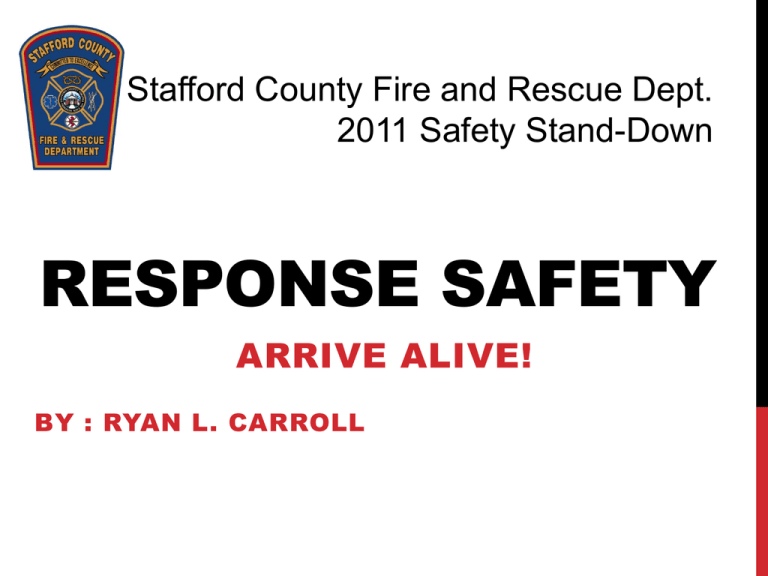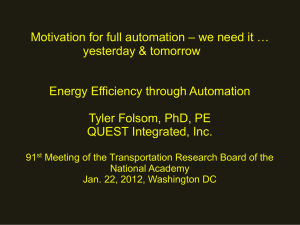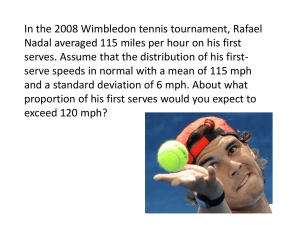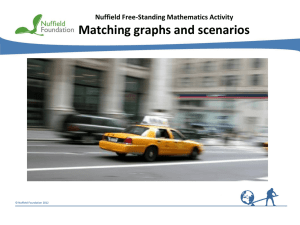driving safety - Stafford County Fire & Rescue
advertisement

Stafford County Fire and Rescue Dept. 2011 Safety Stand-Down RESPONSE SAFETY ARRIVE ALIVE! BY : RYAN L. CARROLL OBJECTIVES: Discuss major causes of vehicle accidents and vehicle related deaths in the fire service Review ways to change or prevent accidents Generate discussion on driving behavior Learn some science behind the accidents Review of scene safety practices HOW ARE WE DYING? Approximately 25% of all fire fighter deaths each year are caused by vehicle accidents. • Emergency and Non-emergency driving The three most common factors • Seatbelts (lack of), Intersections, Speed 11 out of the 85 deaths due to vehicle accidents in 2010 WHAT TIME OF DAY AND WHAT ROAD CONDITIONS ARE THE MOST COMMON IN FIRE DEPT. ACCIDENTS? Daytime and dry road conditions…….. OPEN YOUR EYES!! ACCIDENTS HAPPEN ANYWHERE…. …EVEN CLOSE TO HOME * Photo used with permission of Chief 1 and Safety 1 Accidents can happen to the greenest driver or the most experienced ones. Just because you have “driven these roads for years,” you still must maintain focus. Make sure everyone is seat-belted in….EVERYTIME. SEATBELTS SAVE LIVES! WE KNOW THIS, SO DO IT! WHY DO WE SPEED??? Inexperience • Inexperience leads to over eagerness Statistics • Pressure to get on-scene in a certain amount of time forces faster driving • Why kill your crew and/or civilians because of inadequate staffing? T.V. • T.V. as kids showed us fire trucks going fast, so that’s what we do. CITED ISSUES Many calls are not “serious” problems or false alarms being cancelled during dispatch. • Why kill your crew or another civilian over a stubbed toe? Ignoring a downgraded response. • Radio traffic is recorded, and you can bet a lawyer will retrieve those tapes if you wreck going code 1 Longer distances = longer response times • Drivers may subconsciously drive faster to compensate ISSUES CONT. Ambulances driving too fast going to the hospital. • Providers not secured. • We have advanced life support tools/drugs, unlike the days of the scoop and run without any pre-hospital care. This buys us more time. • Excessive speed and erratic driving hinders proper care. Our “We own the road” mentality • Fire apparatus drivers not yielding at intersections is the most common example and mistake. PREVENTATIVE MEASURES OPTION Training, training, training!!! Speed restrictions Seat belts EXAMPLE Have plenty of “drive time” with a mentor to shadow Limiting speed to no more than 10 mph over the posted speed limit Wear it!!! Every call, every time Education Learn from past mistakes and know driving laws Tiered dispatching Prioritize 911 calls with a response to match. (priority 1 = code 1, etc.) FIRE DEPARTMENT CULTURE • FDNY QUOTE : “WE ARE NOT LEARNING WE ARE NOT CHANGING WE ARE NOT ADAPTING” WE ARE STILL TRYING TO MIMIC THE OLD “SALTY DOGS” AND THE WAY IT WAS DONE IN THE “OLD SCHOOL” WE THINK WE HAVE TO BE TOUGHER, MORE AGGRESSIVE, AND FASTER THAN EVERYONE ELSE. OUR PRIDE AND EGOS BLIND US FROM PROGRESS THESE BEHAVIORS ARE KILLING US AND MUST CHANGE! EVOC Today’s EVOC is not teaching us how to drive, and fail to teach the “science” of operating larger vehicles The infamous VA code 46.2 • Gives us the impression of an open door for “breaking” MOST traffic laws • “Due Regard” clause used after each exemption is an open ended phrase that can be easily manipulated by a lawyer in court. § 46.2-920 OF THE CODE OF VIRGINIA VS. STAFFORD COUNTY SOP’S § 46.2-920 OF THE CODE OF VIRGINIA 1. Disregard speed limits, while having DUE REGARD for safety of persons and property; 2. Proceed past any steady or flashing red signal, traffic light, stop sign, or device indicating moving traffic shall stop if the speed of the vehicle is sufficiently reduced to enable it to pass a signal, traffic light, or device with DUE REGARD to the safety of persons and property; § 46.2-920 OF THE CODE OF VIRGINIA 3. Park or stop notwithstanding the other provisions of this chapter; 4. Disregard regulations governing a direction of movement of vehicles turning in specified directions so long as the operator does not endanger life or property; 5. Pass or overtake, with DUE REGARD to the safety of persons and property, another vehicle at any intersection; § 46.2-920 OF THE CODE OF VIRGINIA 6. Pass or overtake with DUE REGARD to the safety of persons and property, while en route to an emergency, stopped or slow-moving vehicles, by going to the left of the stopped or slow-moving vehicle either in a no-passing zone or by crossing the highway centerline; or 7. Pass or overtake with DUE REGARD to the safety of persons and property, while en route to an emergency, stopped or slow-moving vehicles, by going off the paved or main traveled portion of the roadway on the right. Notwithstanding other provisions of this section, vehicles exempted in this instance will not be required to sound a siren or any device to give automatically intermittent signals. STAFFORD COUNTY SOP’S SOP #0006 (Operations of Emergency Vehicles by Career Personnel) • All personnel operating a vehicle are subject to all the provisions of the motor vehicle code of Virginia, specifically Section 46.2-920 • All personnel are subject to the provisions of the County’s Driver Safety Program STAFFORD COUNTY SOP’S • Drivers will come to a COMPLETE STOP at all red lights and stop signs when possible while responding with lights and siren to ensure that all traffic has yielded the right of way prior to proceeding though the intersection. • During an emergency response, emergency vehicles should avoid passing each other. If passing becomes necessary, the passing arrangements should be conducted through radio communications. STAFFORD COUNTY SOP’S • Avoid backing wherever possible. Where backing an emergency vehicle is unavoidable, a guide must be used to help back the unit. If a guide is unavailable, the operator should dismount and walk completely around the vehicle before backing. CHANGES AND DIFFERENCES New state code is indicating that lights AND sirens must be used when traveling through an intersection. State code does not mandate coming to a complete stop at intersections or stop signs; Stafford does, so make sure you STOP! MATH AND SCIENCE OF DRIVING THE FUN STUFF TERMS Coefficient of Friction Critical Speed of a Curve Total Stopping Distance Braking Efficiency WHAT DO THEY MEAN? Coefficient of Friction • Boils down to how slippery the road is. • Lower the value = slicker the road • This increases braking distances • Dry Roads = .8 - .9 • Wet/Icy Roads = .2 - .3 The bottom line: When it is wet, SLOW DOWN to compensate for the braking distance increase! Critical Speed of a Curve • The maximum speed a vehicle can maneuver through a curve • No matter the skill level of the driver, YOU WILL CRASH if you exceed this speed • This speed changes with the change in Coefficient of Friction • Is calculated by the friction of the road and the radius of the curve (how sharp of a turn) The bottom line: Pay attention to the posted yellow warning signs and SLOW DOWN when the road is wet! The road signs are there for a reason! * Photo used with permission of Chief 1 and Safety 1 Total Stopping Distance • See it, process it, apply the brakes, and stop • Feet per second vs. mph • 55 MPH = 80 FPS • Average brain takes 1.5 seconds to see, process and react to a hazard • So if driving 55 MPH, you will travel almost 120 ft just to react to something. • At 55 MPH, a fire truck takes 194 ft to come to a skidding stop • 120+194= 314 ft…..aka a football field • Remember this when approaching an intersection! The bottom line: Drive defensively, watch following distances, and give yourself braking room! (SLOW DOWN) Braking Efficiency • Air brakes vs. Hydraulic brakes • Hydraulic acts immediately • Air takes almost .5 seconds to engage • At 55 MPH, that is almost 40 extra feet to brake • Truck tires designed for weight and wear • Sacrifice braking ability and traction for durability The bottom line: You need twice as much room to stop a fire truck as you do your car! (SLOW DOWN) * Photo used with permission of Chief 1 and Safety 1 WHAT DO WE GAIN BY SPEEDING??? • Example: Traveling a distance of 8 miles • 35 mph = 13 min, 42 sec • 45 mph = 10 min, 40 sec • 55 mph = 8 min, 43 sec • Example: Traveling a distance of 3 miles • 35 mph = 5 min, 8 sec • 45 mph = 4 min, 0 sec • 55 mph = 3 min, 16 sec NOT MUCH!!! NEED FOR SPEED? How effectively can providers perform CPR in a speeding ambulance? Will those few extra minutes to get to the hospital make the difference? How do we serve those who call 911 if we never make it onscene due to our own accident? Your thoughts?? SCENE SAFETY Traffic Vests and Cones: • Increase visibility and safety to scenes located on roads/highways • Not just another silly SOP/SOG put out by different Fire Departments. TRAFFIC VESTS It has been proven that wearing retro-reflective clothing increases detection distances of people from 125 Ft (in normal clothing) to 890 Ft. • This is VERY significant when considering the braking distances and speeds for the different vehicles approaching your scene. Fire Fighters wearing reflective gear at night CONES Should provide a barrier directing vehicles away from the emergency scene Cones should be placed “tapering” the lane(s) down Tapering distance should increase as speed limits increase Traffic cones should be outfitted with 4” and 6” reflective tape Traffic Cone with 4” and 6” reflective tape SUMMARY Our job is dangerous enough; Don’t add more potential by driving recklessly SLOW DOWN!!! It is not our emergency Pay attention to road signs and road conditions ARRIVE ALIVE





